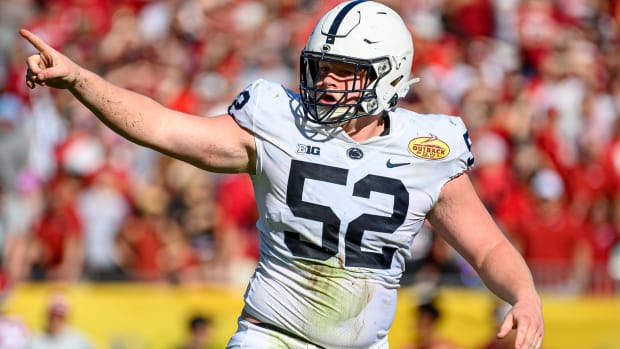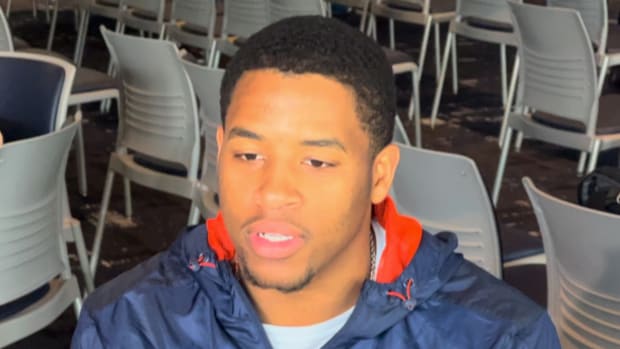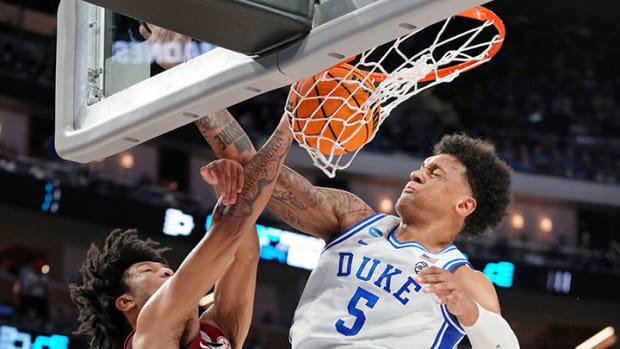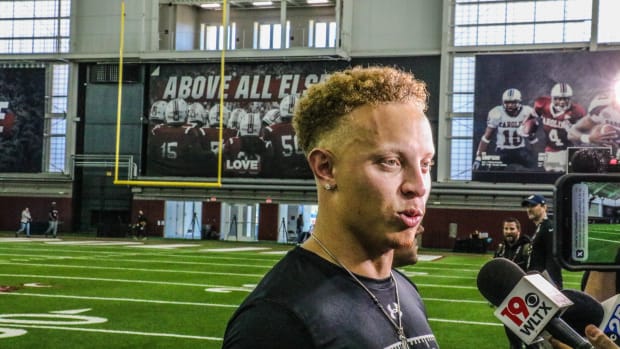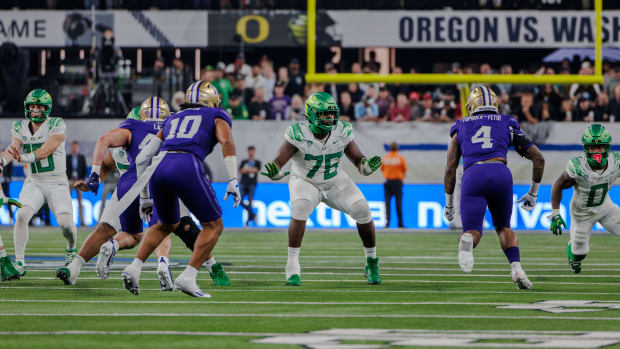
Breaking down the union movement's competitive impact; more mail
Northwestern players will <a href="http://www.chicagotribune.com/business/breaking/chi-northwestern-football-union-vote-20140422,0,4342638.story" target="_blank">formally vote on Friday</a> whether or not to unionize, another landmark moment in the ongoing onslaught against the NCAA's amateurism model. If the <a href="http://www.usatoday.com/story/sports/ncaaf/bigten/2014/04/09/college-football-northwestern-quarterback-trevor-siemian-labor-union/7513271/" target="_blank">public comments from the Wildcats' team leaders</a> are an accurate indication, the players are likely going to vote no, as it's become increasingly clear that many did not realize the extent to which they would be battling their own coach (Pat Fitzgerald) and school when former quarterback Kain Colter initially presented the concept. Mind you, we might not know the results one way or the other immediately. The vote will be impounded pending the school's appeal.
However, <a href="http://sportsillustrated.cnn.com/college-football/news/20140402/northwestern-nlrb-union-ruling-mailbag/index.html" target="_blank">as I wrote a few weeks back</a>, Colter and CAPA already notched a significant achievement when the local NLRB ruled on March 26 that athletes are employees. Northwestern's appeal of that decision will proceed regardless of Friday's vote, and it's clear that the private schools of the FBS are already <a href="http://www.cbssports.com/collegefootball/eye-on-college-football/24534813/players-as-employees-high-costs-of-college-football-union-is-in-millions" target="_blank">bracing for the possibility of a systemic change</a>.
<strong>Stewart, love the Mailbag, thanks for doing it. Regardless of the final result (pay</strong><strong>-</strong><strong>for-play, endorsements, full cost of attendance, etc.) of the union push, we can assume that designating college athletes as employees is intended to give said athletes additional tangible benefits. In that case, the schools with the deepest pockets will be able to disperse the most tangible benefits and therefore get the best players. Does this eliminate smaller, lesser-funded schools from even competing for elite prospects, and therefore competing at elite levels? Is this analogous to baseball, where there is no salary cap?</strong><span></span> <br></br><em>-- Tony, Portland, Ore.</em>
You're hitting on one of the fundamental reasons why NCAA members find themselves in this current predicament. Attempting to legislate a level playing field is seemingly reasonable. Unfortunately, it's not reality. Even without "tangible benefits" (though I'd argue NFL-caliber weight rooms and decadent training tables are tangible benefits), lesser-funded schools aren't competing for elite prospects as it is. By my count, recruits in <a href="https://rivals.yahoo.com/footballrecruiting/football/recruiting/rankings/rank-3202/2014" target="_blank">last year's Rivals250</a> signed with 51 different schools. All but four -- who went to Boise State, BYU, USF and UCF, respectively -- signed with members of the five power conferences or Notre Dame. Even within the power conferences, there's a pecking order: Kansas is not beating out Oklahoma for a prized defensive tackle; Wake Forest is not competing head-to-head with Florida State for the next Jameis Winston.
If the NCAA's members had embraced that reality sooner, maybe they could have provided more benefits and potentially fended off some of these attacks. It's certainly the driving force behind the current move to give the five power conferences legislative autonomy over certain issues. Plenty of smaller Division I schools, particularly those that don't compete in FBS football, aren't keen on possibly putting themselves at a formal disadvantage. But we've reached a point in NCAA history where athlete welfare is finally starting to take precedence over competitive equity in some circles. (Though hardly universally, as evidenced by Kansas State currently <a href="http://www.kansas.com/2014/04/18/3411681/kansas-state-committee-denies.html" target="_blank">refusing a star women's basketball player's release</a> following a coaching change.) The new governance structure with power-conference autonomy is expected to go into effect by August, and one of the first things those leagues will do is push through cost-of-attendance scholarships. If Louisiana-Lafayette, for example, decides it can't afford to spend an extra $3,000 per year on every athlete, it would certainly hurt the Ragin' Cajuns' chances of beating out a school that can for a top prospect. But Louisiana-Lafayette doesn't currently compete for elite recruits. Will things really be that different?
<strong><a href="http://sportsillustrated.cnn.com/college-football/news/20140416/college-football-recruiting-unlimited-meals-proposal/" target="_blank">STAPLES: Unlimited meals? NCAA ruling could add fascinating layer to recruiting</a></strong>
Football and men's basketball may not be the best examples of sports where the small-market effect will be felt the most. There is no shortage of non-revenue sports where lower-profile schools are nationally competitive. Think Cal-State Fullerton in baseball, for instance. Or Union College in hockey, as the Dutchmen recently beat Minnesota in the NCAA championship game. Can these schools realistically maintain their level of play if hit with an additional financial burden? Especially given the fact they'd almost certainly have to offer any extra benefits across the board, not just to one specific team? Possibly not.
Then again, it would be narrow-minded to assume that all athletes will pick their schools based on which can offer the best financial package. If a kid really likes a certain coach and program, and his family can afford college based on the current athletic scholarship model, it might not be an issue as often as many assume.
<strong>Hi Stewart. On Friday, Northwestern players will vote on whether or not to unionize. While this is certainly a major story from a "future of the sport" perspective, I think there is also an interesting story here about what this means for the 2014 Wildcats. Do you see this vote, especially with the team's quarterback (Trevor Siemian) stating he is anti-union, potentially being a divisive issue that will split the locker room? What are this season's possible ramifications?</strong><span></span> <br></br><em>-- Matt M</em><em>.</em><em>, Chicago</em>
I'm interested to find out. No other team in the country is dealing with anything quite as contentious within its program walls. The union vote has already <a href="http://dailynorthwestern.com/2014/04/16/sports/football-team-alumni-meet-to-discuss-northwestern-unionization-effort/" target="_blank">created some unfortunate divisiveness</a> among Northwestern's alumni, with some former players accusing others of pressuring the current players to vote no. According to <a href="http://www.cbssports.com/collegefootball/writer/jeremy-fowler/24534155/document-reveals-northwesterns-anti-union-dialogue-with-players" target="_blank">documents obtained by CBSSports.com</a>, the players and their families are engaged in the process, asking questions to stay informed. To call this a distraction, as coaches often refer to any non-football matters, is an understatement. Colter essentially put the program on trial. How could that not create some hard feelings?
Still, that doesn't necessarily mean the union push will impact the Wildcats' season. Fortunately for Fitzgerald, the vote is taking place in April, not in August. It will be ancient history by kickoff. If the players vote no, the story will go away, provided the results are tallied before then.
And finally, let's remember that Northwestern is coming off a bitterly disappointing season in which injuries and some incredibly bad luck contributed to a seven-game losing streak. Knowing the mindset of a typical 18-to-22-year-old, that's a far bigger factor heading into this fall than whether the lineman to the right or left of a given player is pro- or anti-union.
<strong><a href="http://sportsillustrated.cnn.com/college-football/news/20140410/northwestern-wildcats-spring-practice/index.html" target="_blank">HAMILTON: As union effort progresses, Northwestern focused on bouncing back</a></strong>
<strong>Stewart, would you please parse </strong><strong><a href="http://www.al.com/sports/index.ssf/2014/04/ed_obannon_v_ncaa_summary_judg.html" target="_blank">the latest from the Ed O'Bannon lawsuit</a></strong><strong> into layman's terms? It seems procedural, but you are far more qualified than most (and certainly me) to put this in perspective in terms of where the case stands and what the next steps are.</strong><span></span> <br></br><em>-- Michael, San Diego</em>
Sure thing, Michael. Barring a settlement (not likely), the case will finally go to trial on June 9 at the U.S. District Court in Oakland, Calif. This case is by far the biggest threat to the NCAA right now, much more than the unionization movement, so I'm all for inquisitive questions about it.
First, a quick refresher on the gist of the case. The plaintiffs, consisting of both current and former athletes, contend that the NCAA and its member schools conspired to set the price of college athletes' names, likenesses and images at zero in violation of antitrust law. They argue that athletes should be allowed to negotiate licenses for use of their NLI in game broadcasts, a la professional sports player unions. Important note here: This is no longer about video games, as was initially the case. EA Sports and the Collegiate Licensing Company, originally co-defendants, settled last year for $40 million. The case is now primarily about whether athletes are entitled to negotiate a share of the billions of dollars in TV revenue generated from broadcasting college games. The judge ruled last year that the certified class cannot pursue past damages, but it can proceed with an injunctive attempt to alter NCAA policy.
The most recent development was largely a formality. Following a February hearing, the judge, as expected, ruled against both sides' requests for summary judgment. But there were a couple of noteworthy items in her decision. For one, the NCAA has posited five "precompetitive" justifications for limiting athlete compensation. Judge Claudia Wilken denied one of them -- the notion that sharing revenue with football and basketball players would cut into funding for women's and non-revenue sports. "The NCAA has not explained why it could not adopt more stringent revenue-sharing rules," Wilken wrote. She also cast doubt on the NCAA's position that its first amendment rights to broadcast a newsworthy event, like a football game, preclude it from having to obtain athletes' permission to use their likenesses (just as newscasters aren't required to seek waivers from anyone who might appear on screen during coverage of a breaking story). Her admonishment could shape the NCAA's defense strategy at trial.
<strong>Stewart, so surprised that you made such a simple mistake when a little research would have been so easy. You </strong><strong><a href="http://sportsillustrated.cnn.com/college-football/news/20140409/heisman-trophy-college-football-playoff-mailbag/index.html" target="_blank">mentioned that you would like to see</a></strong><strong> some future Big 12-Big Ten matchups, including a renewal of Texas-Ohio State. That series is already on the calendar in 2022 and '23.</strong><span></span> <br></br><em>-- Geoff Schechter, Lexington, Mass.</em>
Good to know. I must have missed that one. I haven't yet tacked up my 2022 and '23 schedule posters.
<strong>If I've counted correctly, there will be 39 bowls after the 2015 season (not including the new national title game), which will require 78 bowl-eligible teams. Last year there were 79 bowl-eligible teams, but there were only 72 in '11 and '12. I can't imagine that any bowl would simply be canceled i</strong><strong>f</strong><strong> it couldn't land a pair of 6-6 programs, so I'm guessing someday we'll have two 5-7 teams fighting for supremacy in Albuquerque or Shreveport. Is this really what we want bowl season to become?</strong><span></span> <br></br><em>-- Dr. Nick, Los Alamos, N.M.</em>
First of all, thank you for not including the national championship game among the total number of bowl games. I know this is nitpicky, but following the recent announcement of the new Cure Bowl in Orlando, which begins next year, I saw a lot of articles claiming that there will now be 40 bowl games. However, the new College Football Playoff championship game, the first of which will be played on Jan. 12 in Arlington, Texas, is not a bowl game. It is not sponsored by a bowl committee. There will be no bowl-week activities. And most pertinently, the two teams involved will have already played in their bowl games during the semifinal round. So, it's 39, up from 35 in recent years, with the additions this year of the Boca Raton Bowl (featuring grand marshal Morty Seinfeld), Miami Beach Bowl, Bahamas Bowl and Camellia Bowl in Montgomery, Ala., and the subtraction of the old BCS championship bowl.
As for the number of eligible teams, organizers are definitely cutting it close, but keep in mind that the overall number of FBS teams has spiked in recent years. In 2011, there were 120 squads vying for 70 bowl berths. In '13, there were 125, and not coincidentally, the number of bowl-eligible teams increased. This year, 128 teams will compete for 76 spots; next year 129 teams will challenge for 78. Many of the newcomers will initially help some incumbents get to six wins.
We came darn close to having a 5-7 bowl team a couple of years ago, and I don't doubt things will come to that at some point. In fact, the <a href="http://espn.go.com/college-football/story/_/id/8228544/ncaa-new-bowl-game-tiebreakers-include-fcs-wins-5-7-teams" target="_blank">contingency plan is already in place</a>, with first dibs going to teams with a high APR score. And the biggest threat, just as it was a couple of years ago, is the prospect of ineligible programs. This year, Penn State and UNLV are ineligible. UNLV is out for an insufficient APR score (like Connecticut basketball was a couple of years ago), which, with the NCAA recently upping the postseason benchmark from 900 to 930, could become more commonplace. Several schools -- including Tennessee, Louisville and Oklahoma State -- fell slightly below that APR mark last year, but the new minimum had not yet gone into effect.
<strong>Remember in 2011 when the Big 12 chose to add West Virginia over Louisville because West Virginia was supposedly a better football school? Given their records since '12 (the Cardinals ar</strong><strong>e</strong><strong> 23-3; the Mountaineers are 11-14) and the fact that Louisville is 400 miles west of Morgantown, do you think the Big 12 wishes it could have a mulligan?</strong><span></span> <br></br><em>-- Josh Loschen, Platteville, Wis.</em>
No question. Remember, there was a contingent within the Big 12 -- most notably Oklahoma president David Boren and athletic director Joe Castiglione -- who pushed for Louisville back then. But program perceptions can vary drastically given the specific snapshot in time. In October 2011, Louisville football was just getting off the ground under Charlie Strong, coming off a Beef 'O' Brady's Bowl victory over Southern Miss. West Virginia was a nationally ranked team en route to a 10-win campaign and 70-33 Orange Bowl rout of Clemson. West Virginia's program had more history and was considered a bigger TV brand. And there wasn't much separation at that point between Bob Huggins' and Rick Pitino's basketball programs.
Since then, both schools have trended in completely opposite directions in both sports. In fact, not until the move actually came to fruition did both sides realize just how logistically challenging it would be for Texas and Oklahoma schools to travel to Morgantown (which generally requires flying to Pittsburgh and driving about 80 minutes), and vice versa. However, at that moment in 2011, with the Big 12 about to lose Missouri and West Virginia's conference crumbling, both parties needed to act quickly. As it is, Louisville wound up better off in the ACC, though it, too, might take an initial step back.
Meanwhile, of the Big 12's two newcomers, TCU -- not West Virginia -- has had the most difficult transition. The Horned Frogs have gone 11-14 in football and a putrid 2-34 in men's basketball conference play.
<strong><a href="http://college-football.si.com/2014/04/21/spring-game-recap-alabama-texas-usc/" target="_blank">ELLIS: Analyzing the latest developments from spring games across the country</a></strong>
<strong>Stewart, what do you think of Colorado's chances of making a bowl game this year? It was just seven years ago that the Buffaloes faced off against Alabama in the Independence Bowl. Coach Mike MacIntyre's former San Jose State team improved four wins between his first and second seasons. Can he get Colorado to six wins?</strong><span></span> <br></br><em>-- Jordan, New Orleans</em>
MacIntyre's Spartans did indeed improve from 1-11 in 2010 to 5-7 in '11, and that was before the arrival of star quarterback David Fales, who led San Jose State to an 11-2 mark the following season. But that was in the WAC, not the Pac-12. Colorado's 4-8 record last year belies the fact that it allowed 40 or points or more and lost by at least 17 points in all but one of its eight defeats. Its lone conference win came over 1-11 Cal.
The goal for 2014 will likely be to get more competitive, and to do so despite having a very young roster. I could see the Buffs' defense improving, but the offense struggling, at least initially. Still, I would be willing to bet that Colorado reaches a bowl game by the following year. The coaches have a young quarterback they like in rising sophomore Sefo Liufau, and redshirt freshman receiver Bryce Bobo had a big spring and could help replace some of the production of departed star wideout Paul Richardson.
<strong>Hi Stewart. Like many, I'm a longtime college football fan. Unlike many, I'm British, live in London and have seen only a handful of big-time games in person. I'm going to spend a week next year during conference season seeing a couple of games. Importantly, I'll be bringing three sports-mad friends completely new to football, especially the college variety. Therefore the style and pace of play, crowd, activities during the week, tailgating scene, and liveliness and friendliness of the</strong><strong> </strong><strong>town and surroundings are all as important as whether the teams are relevant in the playoff race. Which games/places would you pick?</strong><span></span> <br></br><em>-- Mark, London</em>
To truly experience as many different styles and scenes as possible, I think you need to hit three games in a week. Here's the itinerary I've come up with:
? Sat., Sept. 27: Tennessee at Georgia. Visit the new College Football Hall of Fame in Atlanta, then make the short drive to Athens, where your friends will get a taste of all things SEC football: the sundresses and the khakis, the Redcoats, Uga, the hedges and Todd Gurley running between the tackles.
? Thu., Oct. 2: Arizona at Oregon. Five days later, your friends will think they're watching a completely different sport. Willamette Valley should be resplendent in early October. Arrive early, check out the Death Star complex next to Autzen Stadium and enjoy a Wild Pacific Salmon Sandwich on your way into the game.
? Sat., Oct. 4: Stanford at Notre Dame. Touchdown Jesus, the Grotto, Rudy -- the pageantry at a Notre Dame game never disappoints, even if the team often does. Then you'll have an easy trip back on Sunday from O'Hare.
So ... can I come?
This was fun. Let's do another Mailbag next week.
<em>Dear Mailbag readers: Due to technical issues, I have not been receiving recent emails. Please resubmit your questions to mandelpodcast@gmail.com.</em>
